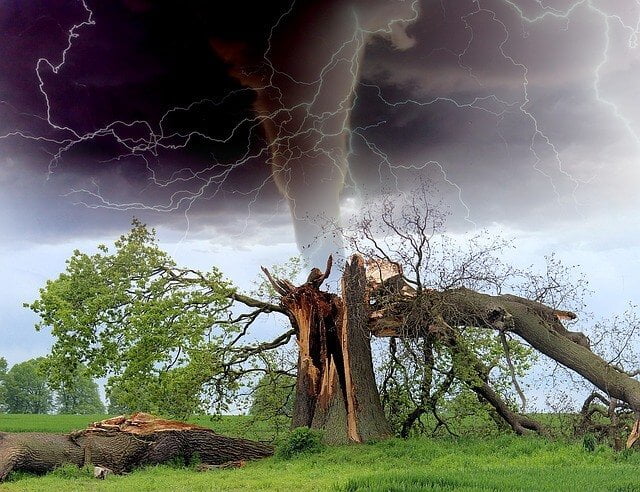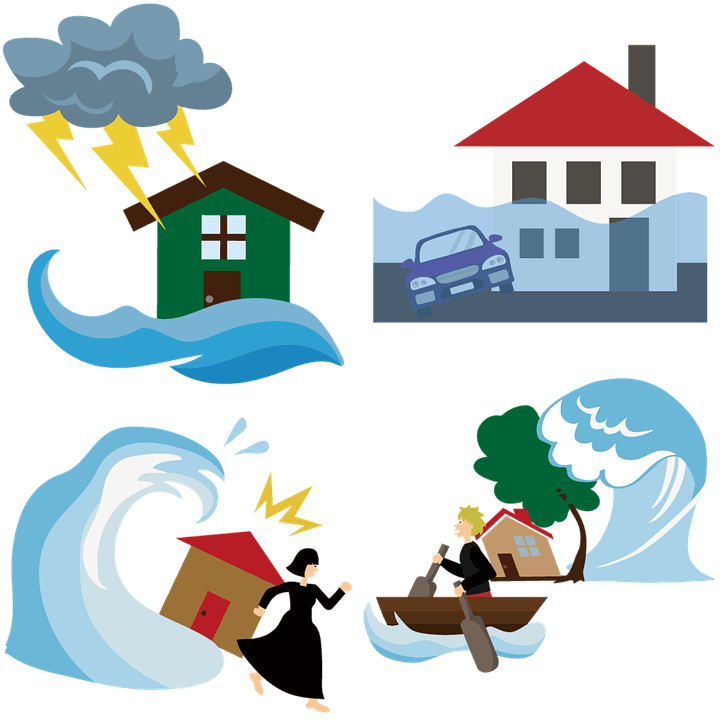
Indian seas are no strangers to cyclones, on average India plays host to six cyclones that displace or end millions of human lives each year.
A cyclone is a large mass of air that rotates around a strong centre of low atmospheric pressure, counterclockwise in the Northern Hemisphere and clockwise in the Southern Hemisphere.
Cyclone, hurricane, typhoon or storm all mean the same depending on which part of the world you are based in. For instance, a windstorm in the Indian and South Pacific Ocean is called a cyclone, similar commotion in the Atlantic or the eastern Pacific Ocean is called a hurricane, while a tropical cyclone that develops between 180° and 100°E in the Northern Hemisphere referred to as Northwestern Pacific Basin is called a typhoon.
The Bay of Bengal witnesses some of the worst cyclones. Widespread death and property destruction are reported every year in the coastal states of West Bengal, Orissa, Andhra Pradesh, and Tamil Nadu. Likewise, the areas along India’s western coastline bordering the Arabian Sea are known for occasional cyclones in Gujarat and Kerala. The 1737 Calcutta cyclone, Bhola cyclone (1970), and the 1991 Bangladesh cyclone rank among the most powerful cyclones to strike India, and neighbouring Bangladesh.
With peak winds of 257 km/h cyclone 05B, a supercyclone that struck Orissa on 29 October 1999, was the deadliest in more than a quarter-century. It left almost two million people homeless and another 20 million lives were disrupted by the cyclone.
Here is a list of some of the most powerful cyclones that hit India in 2020-2021:

Cyclone Yaas
Meteorologists predict that Cyclone Yaas will probably have the same or even higher intensity than Cyclone Titli that wreaked havoc in Odisha in 2018. As per the estimated central pressure and wind speed by all models, it seems certain that the developing Cyclone Yaas will be a severe or extremely severe category storm. The second storm in 2021 and the first over the Bay of Bengal this year has been given the name Yaas, given by Oman. The Met department has forecast that the low-pressure system will bring heavy rain along the Andaman and Nicobar Islands, Odisha, West Bengal, Meghalaya and Assam.
Cyclone Tauktae
Cyclone Tauktae (pronounced as Tau’Te) Taukte is named after a lizard which as per folklore in Myanmar has the ability to forecast weather. It is formed by two words ‘Tauk’ meaning rain and ‘Te’ is wind. The lizard is believed to give a call ‘Taukte’ before the rain… If it stops at ‘Tauk’ it means more rain will come but if it stops at ‘Te’ more wind will come. Cyclone Tauktae was the first cyclonic storm of 2021 in the Arabian Sea with windspeed between 150 – 160 kmph. Classified as a very severe cyclonic storm (VSCS), it left behind a trail of destruction across Maharashtra, Karnataka, and Gujarat besides widespread rain in Rajasthan, Uttarakhand, Himachal Pradesh, Uttar Pradesh and Delhi. It left behind a trail of destruction with many people losing their lives, thousands of trees uprooted, houses destroyed, and electric poles massively damaged. Around 70,000 electric poles were uprooted and around four 220-KV sub-stations were damaged leading to a blackout in some 5,951 villages of Gujarat. Amreli, Gir Somnath, Junagadh, Porbandar, Rajkot, Bhavnagar and Botad were among the worst affected districts in the Saurashtra region.
Cyclone Amphan
With a sustained wind speed (MSW) of 230 km/h, cyclone Amphan was the strongest cyclone over the Bay of Bengal in the 21st century and also the fourth highest since the beginning of record-keeping. The United States Joint Typhoon Center (USJTC) measured the cyclone’s peak wind speed at 270 kilometres per hour (km/hr) making it the strongest cyclone ever to have been recorded in the Bay of Bengal. It was given the name Amphan by Thailand pronounced as “Um-pun” meaning sky.
Cyclone Nisarga
Cyclone Nisarga was the second pre-monsoon cyclone that emerged from the Arabian Sea in June 2020. It was given the name Nisarga, meaning nature by Bangladesh. It was the strongest tropical cyclone to strike Maharashtra in the month of June since 1891 and also the first cyclone to impact Mumbai since Phyan of 2009. It struck the Indian subcontinent within two weeks of Cyclone Amphan, the first super cyclonic storm formed in the Bay of Bengal in the 21st century. The cyclone caused 6 deaths and 16 injuries in Maharashtra.
Cyclone Kyarr
Cyclone Kyarr classified as a “super cyclonic storm” by the India Meteorological Department — was the first storm of such intensity in the Arabian Sea in 12 years. Kyarr meaning ‘Tiger’ in the Burmese language was given the name by Myanmar’s meteorological department. Interestingly Cyclone Kyarr the second most intense tropical cyclone on record in the Arabian Sea was named even before it was formed. Cyclone Kyarr developed in the Arabian Sea and moved towards the Gulf of Aden from the Indian coast. It hit Western India, Oman, UAE, Socotra and Somalia.
Cyclone Maha
Cyclone Maha named by Oman developed in the Comorin Sea (near the southernmost end of India). It was an extremely severe cyclonic storm that became very intense while moving parallel to the Indian coast. It was a rare coincidence, though not unprecedented that Cyclone Maha and cyclone Bulbul led to strong winds and very heavy rainfall in the Bay of Bengal and the Arabian Sea at the same time.
Cyclone Vayu
Cyclone Vayu was a very severe cyclonic storm that caused moderate damage to lives and property in Gujarat in June 2019. It was the strongest tropical cyclone to affect the Saurashtra Peninsula of northwestern India since the 1998 Gujarat cyclone. Cyclone Vayu also affected Maldives, Pakistan and Oman Along with India.
Cyclon Hikka
Kyarr, Maha, Vayu and Hikka — four major cyclones — caused major disturbance in the Arabian Sea in 2019. Cyclonic activity is comparatively less intense in the Arabian sea as compared to the Bay of Bengal, where high-intensity severe cyclones originate frequently. In the last 120 years, just about 14% of all cyclonic storms, and 23% of severe cyclones, around India have occurred in the Arabian Sea.
Cyclone Hikka emerged from the Arabian Sea and turned intense and hit Oman. Hikaa formed west of India in the Arabian Sea on September 22. The storm reached peak intensity, with maximum sustained winds estimated over 140 km/h (85 mph) on September 24.
Cyclone Fani
Cyclone Fani was the strongest tropical cyclone in the Bay of Bengal by 3-minute maximum sustained wind speed and minimum barometric pressure. With wind speeds of up to 200 kmph, cyclone Fani caused huge destruction to lives and property in Odisha, West Bengal, Andhra Pradesh and East India in addition to Bangladesh, Bhutan and Sri Lanka.
Cyclone Bulbul
Cyclone Bulbul was a very severe, strong and very damaging tropical cyclone which caused storm surge, heavy rains, and flash floods that resulted in the destruction of lives and property in India, and Bangladesh in November 2019.

